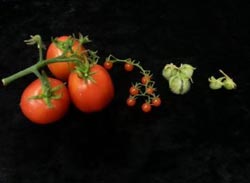Comparing genomes of wild and domestic tomato

Researchers can now compare not only the genomes, but all the genes expressed, by domestic and wild tomatoes. L to R: Solanum lycopersicum, and wild relatives S. pimpinellifolium, S. habrochaites and S. pennellii.<br><br>Credit: Brad Townsley, UC Davis.<br>
The results give insight into the genetic changes involved in domestication and may help with future efforts to breed new traits into tomato or other crops, said Julin Maloof, professor of plant biology in the College of Biological Sciences at the University of California, Davis. Maloof is senior author on the study, published June 24 in the journal Proceedings of the National Academy of Sciences.
For example, breeding new traits into tomatoes often involves crossing them with wild relatives. The new study shows that a large block of genes from one species of wild tomato is present in domestic tomato, and has widespread, unexpected effects across the whole genome.
Maloof and colleagues studied the domestic tomato, Solanum lycopersicum, and wild relatives S. pennellii, S. habrochaites and S. pimpinellifolium. Comparison of the plants' genomes shows the effects of evolutionary bottlenecks, Maloof noted — for example at the original domestication in South America, and later when tomatoes were brought to Europe for cultivation.
Among other findings, genes associated with fruit color showed rapid evolution among domesticated, red-fruited tomatoes and green-fruited wild relatives. And S. pennellii, which lives in desert habitats, had accelerated evolution in genes related to drought tolerance, heat and salinity.
New technology is giving biologists the unprecedented ability to look at all the genes in an organism, not just a select handful. The researchers studied not just the plants' DNA but also the messenger RNA being transcribed from different genes. RNA transcription is the process that transforms information in genes into action. If the DNA sequence is the list of parts for making a tomato plant, the messenger RNA transcripts are the step-by-step instructions.
Gene-expression profiling, combined with an understanding of the plants' biology, allows researchers to understand how genes interact to create complex phenotypes, said Neelima Sinha, professor of plant biology at UC Davis and co-author on the paper.
“Genomics has fast-tracked previous gene-by-gene analyses that took us years to complete,” she said.
“We could not have done a study like this ten years ago — certainly not on any kind of reasonable budget,” Maloof said. “It opens up a lot of new things we can do as plant scientists.”
The study is the result of a collaborative NSF project awarded to Sinha, Maloof and Jie Peng, associate professor of statistics at UC Davis. Additional authors on the paper are: Daniel Koenig, José Jiménez-Gómez, Seisuke Kimura, Daniel Fulop, Daniel Chitwood, Lauren Headland, Ravi Kumar, Michael Covington, Upendra Kumar Devisetty, An Tat, Mallorie Taylor-Teeples, Siobhan Brady, all at UC Davis; Takayuki Tohge, Alisdair Fernie, Anthony Bolger and Björn Usadel, all at the Max Planck Institute of Molecular Plant Physiology, Golm, Germany; Korbinian Schneeberger, Stephan Ossowski, Christa Lanz and Detlef Weigel, all at the Max Planck Institute for Developmental Biology, Tübingen, Germany; and Guangyan Xiong and Markus Pauly, both at UC Berkeley.
Media Contact
More Information:
http://www.ucdavis.eduAll latest news from the category: Life Sciences and Chemistry
Articles and reports from the Life Sciences and chemistry area deal with applied and basic research into modern biology, chemistry and human medicine.
Valuable information can be found on a range of life sciences fields including bacteriology, biochemistry, bionics, bioinformatics, biophysics, biotechnology, genetics, geobotany, human biology, marine biology, microbiology, molecular biology, cellular biology, zoology, bioinorganic chemistry, microchemistry and environmental chemistry.
Newest articles

Machine learning algorithm reveals long-theorized glass phase in crystal
Scientists have found evidence of an elusive, glassy phase of matter that emerges when a crystal’s perfect internal pattern is disrupted. X-ray technology and machine learning converge to shed light…

Mapping plant functional diversity from space
HKU ecologists revolutionize ecosystem monitoring with novel field-satellite integration. An international team of researchers, led by Professor Jin WU from the School of Biological Sciences at The University of Hong…

Inverters with constant full load capability
…enable an increase in the performance of electric drives. Overheating components significantly limit the performance of drivetrains in electric vehicles. Inverters in particular are subject to a high thermal load,…





















